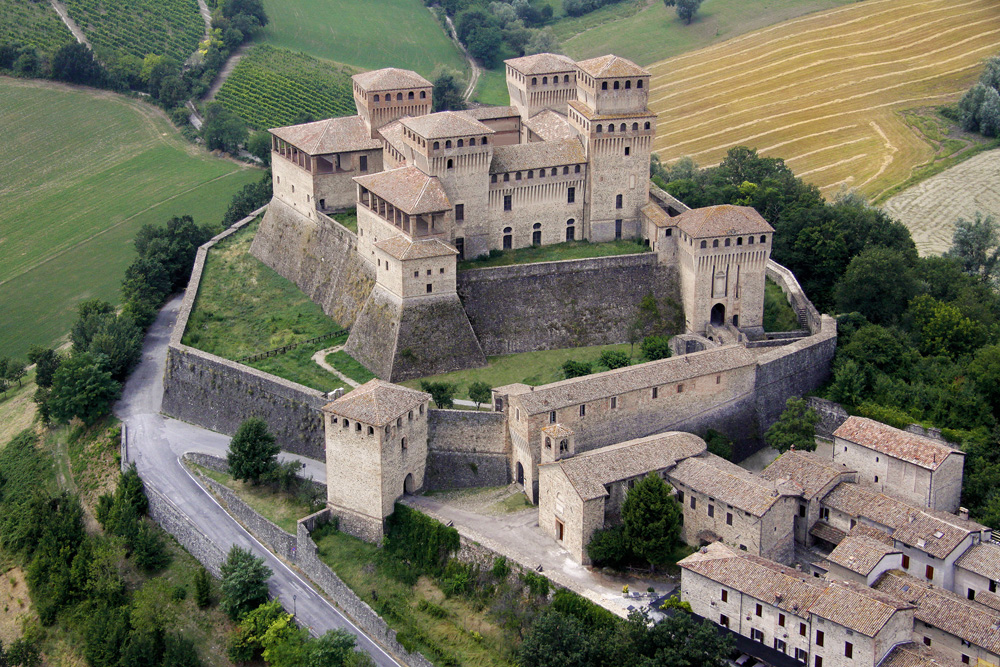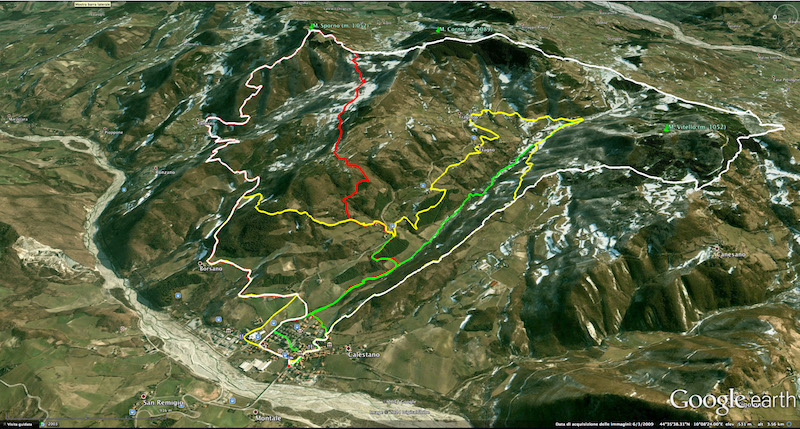CALESTANO
Lying on the hills of the Parma Apennines,Calestano is a charming medieval village
even if the area has been inhabited since the prehistoric times. The place was in fact
the subject of important archaeological finds. Along the streets of the historic
village, it is possible to admire views of great interest through an itinerary that winds
through the alleys, the vaulted passages and an irregular portico (in shapes and
sizes) indicating a remote origin and it is a rare example of the use of city types in an
Apennines locality.
The oldest part of the village consists of an urban structure dating back to the
Middle Ages; here you can admire the “Bastia” dating back to the fifteenth century,
with ancient buildings and the fortified outpost of the hypothetical fortress,
consisting of stone houses and paved streets. Via Mazzini, the main rode, today is
located in the place of Rio Saint Agata, which was interred in the second half of the
nineteenth century. The main road corresponded to the current “Borgo Manone”
which winds from the Majesty located to the South and reaches the square of the
parish church dedicated to Saint Lawrence. Inside the church several and
considerable works of art are kept.
Inside the historic village there are ancient palaces and internal courtyards: Corte
Ortalli, Corte Rignani and corte of Tarasconi Palace. Calestano was the most
important medieval fief in the Po valley. It belonged to Fieschi Family, counts of
Lavagna (Pope Sinibaldo Freschi, elected with the name of Innocent IV, belonged to
this family). In 1426 there was a war and the viscounts took possession of these
areas and returned them only in 1439 (to Gianantonio Fieschi) as a sign of gratitude
for his devotion to Filippo Maria Visconti. In 1650 Carlo Leone and Claudio Fieschi
gave up the fief of Calestano, Marzolara, Vigolone and Alpicella with all the
appliances in favour of count Camillo Tarasconi.
The Monument to the Fallen of all Wars is located in Calestano in the green area in
front of the primary school and is dedicated to the fallen of all wars in the fiftieth
anniversary of the end of the Great War (1918-1969). Built in 1968, it is supported
by a base of four steps and is limited by four marble pillars. Almost entirely made of
red marble, it is made up of interlocking geometric shape slabs. Among these stands
a bronze semicircle that reproduces the stylized shape of the sun. In the central plate
stands a flame in bronze pointing towards the sky. The dedication to the Fallen of all
Wars rests on the base.
RAVARANO
Along the provincial road that crosses the village of Ravarano there is a valuable
monument erected in 1939 thanks to the donations of the residents. It consists of a
square marble base on which stands a statue of white Carrara marble representing
the victorious infantryman who defends the flag. It was inaugurated in solemn form
on November 4, 1939 and it bears the names of the people who lived in Ravarano
and fell during the Great War. Subsequently, two more tombstones were added to
the base: the first one bears the name of those who fell during the Second World
War, the second one represents the names of the Partisans of Ravarano, captured
and murdered by Nazi in this land of fight against Nazi-Fascism.
The castle of Ravarano
The locality preserves the medieval origin and a village that is now partially salvaged
with typical stone houses. The castle that overlooks it is a fortified building built
around the year one thousand and placed in a dominant position over the Val
Baganza. Nearby there is an ancient oratory which is now in ruins. The locality is
divided into small villages: the Castle, the Villa, the the Latta, the Costa, the Borello
and the Peschiera, where in ancient times there was a lake and now stands the
church of Saint Bartholomew, built in the place where the baptismal font of the
ancient church was found.
BORSANO
A small hamlet located higher than Calestano and known for its Majesty and the
original, little ancient oratory dedicated to Saint Genesius, also called of the Holy
Trinity because this Saint was depicted with the Holy Trinity on the canvas placed on
the altar. Every summer, on 25 August it is possible to visit it during the celebration
of Saint Genesius. During the religious ceremony, widely celebrated in the valley, red
bracelets are distributed: they commemorate the martyrdom of the Saint and
according to a popular belief, they protect the children from winter season's bugs.
IANO
This small locality is known for its prehistoric caves, located a short distance from the
village and also for the suggestive oratory located on a small hill in an isolated
position. The building dates back to the seventeenth century and stands on the
foundations of a medieval oratory already mentioned in 1200 according to some
studies which arose on a place of worship from the Roman era dedicated to the God
Janus (from here comes the name of the village). It was sadly known during the
Second World War, when the Nazi ferocity caused numerous victims. During the
round ups of the German troops, several Partisans found refuge in the attic of this
oratory and were helped by the inhabitants who secretly brought them food during
their stay in this hole.
MARZOLARA
Formerly made up of a small village, it was a charming ski resort in the early
twentieth century. There is an ancient Tramvai station that came up from the city of
Parma and now has been restored and has become the home to a commercial
establishment. The Sanctuary of Saint Mary of Peace is of particular importance: it
preserves a copy of an ancient painting located in Rome in Saint Mary of Peace and
coming from the homonymous oratory in Parma, now closed. Significant is the Via
Crucis made of iron, which starts from the Sanctuary and climbs towards the old
castle now destroyed, and inaugurated in 2000, the year of the Jubilee. The project
testifies to the local devotion of the citizens; the various stations are made of steel
with a concrete base from which rise two steel blades that support a bronze
medallion surrounded by three circular blades that represent the centrifugal and
centripetal forces of the Holy Spirit who is the beginning and end of everything. The
Via Crucis ends with a large steel cross that dominates the village from the top of
Castello.
FRAGNO
The hamlet was inhabited since pre- Roman times, as evidenced by important
findings in Castellaro di Fragno, a settlement dating back to 1500 BC, attributable to
the presence of the Ligurian populations, strongly rooted in Val Baganza until the
Roman conquest. In the ancient village there is the church dedicated to Saint Peter,
mentioned since 1230 among the dependencies of the Pieve of Castrignano. It owes
its current appearance to the renovations of 1660 . The octagonal spire bell tower in
terracotta from the end of the seventeenth century is very characteristic. The
neoclassical facade dates back to 1858.
The stone monument to the truffle was born from an idea of the art master Paolo
Sacchi, and it was made with a number of about 130 stone purchased during the
2016 National Black Truffle Fair in Fragno by numerous benefactors who contributed
to the realization of the same. This project carried out by hand by the stonecutters
has allowed the Proloco of Calestano to deserve the second prize in the national
competition “Immeasurable beauty”, for having updated and valued an artisan and
territorial competence around the creation of a concrete object, giving way to
people to create, thanks to the realization of the sculpture, a sense of belonging and
community.
CANESANO
The bell tower of the fifteenth century. In the Annunciation church there is an
ancient baptismal font made of Chiastre stone with primitive Romanesque motifs.
VALLERANO
Here it is the beautiful Church of Saint Jacobs which maintains its original stone
structure and the small cemetery. Nearby the agritourism La Macchia Tonda is
cultivated the truffle which ensures the production of the precious Tuber Uncinate
coming from Fragno. Moreover, in the agritourism you have the possibility to make a
reservation and look for truffles with a dog.
ALPICELLA
Starting from the ancient Bastia in the centre of Calestano, leaving the village in the
direction of Canesano, you arrive in the locality of Alpicella. At present, it is an
agglomeration of houses in which an ancient fortress and the oratory of Saint Agata
were once located but today they are in ruins.
RAMIANO
The church, dedicated to Saints Gervase and Protasio, is surrounded by an ancient
urban layout typical of the villages located halfway. Inside there is a seventeenth
century altarpiece with the original carved frame. You can admire a processional
cross in embossed and chiselled silver from the seventeenth century.
VIGOLONE
Vicus Hugonis today Vigolone is the destination of many Parmesan and others who
go there to take advantage of a source of mineral water rich in healing properties,
especially diuretic. The church dedicated to Saint John the Baptist dates back to the
Middle Ages and was rebuilt at the end of the nineteenth century. The rectory is
particularly noteworthy, austere building dated 1594. Only a few traces of the castle
remain submerged by vegetation.


